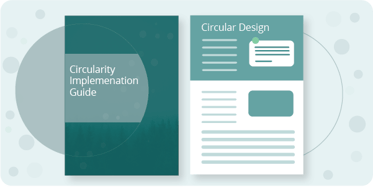In the world of sustainability, “circularity” has become the latest and greatest buzzword and with good reason. As a design ideal it's very compelling but to drive real systems change we need to make sure the end goal of reducing environmental and social impacts are being delivered. Many companies have laid claim to the term in their marketing efforts, so much so that legitimate skepticism is being raised in some cases. With circularity being arguably one of the most impactful ways we can ensure a sustainable future, it is imperative that we look at current efforts with a critical eye and re-evaluate what it will take for us to fully embody a circular economy.
We're creating a Circularity Series to dive deeper into the circular economy model and what it means for product manufacturers. Within this Circularity Series, we will aim to:
- Define circularity in detail and orient its goals relative to current efforts
- Explore the necessary material transparency component of circularity
- Review the role of supplier data disclosure and Extended Material Responsibility
- Provide strategies for creating circular products
- Highlight several companies that have deeply embraced circular design and the challenges they are still working on.
Keep up with us throughout the month of October to join our circular journey!
What is circularity?
To begin a candid conversation about circularity, we first need to understand what it is by definition. When someone says “circularity”, this is a shortened and equivalent version of “circular economy”. The Ellen MacArthur Foundation, a leading organization in circularity, defines it as a systems solution framework that tackles global challenges like climate change, biodiversity loss, waste, and pollution. It is based on three principles: (1) design out waste and pollution, (2) keep materials in use at their highest value, and (3) regenerate nature. A transition to a circular economy means decoupling economic activity from the seemingly infinite consumption of finite resources while recognizing that circularity is underpinned by a system of restorative and regenerative design.
A circular economy of finite resources can be broken down into four levels, in order of most to least desirable: (1) maintain and/or repair, (2) reuse and redistribute, (3) refurbish and remanufacture, and (4) recycling of the product. To read more about these levels of circularity, download our Circularity Guide.
What does circularity really mean in practice?
With an understanding of what circularity is, it is crucial to revisit the stakes. Circularity was devised to specifically address issues of climate change and biodiversity loss through the reduction of greenhouse gasses, waste, and pollution. In order to realize that goal and make meaningful global change, manufacturers and corporations must take action in true alignment with the principles of circularity.
In an effort to adopt sustainable practices, we can see organizations establishing new initiatives such as calculating and offsetting their footprints, or recycling materials into their supply chain and marketing it as circularity. While proper recycling holds an important place in the circular economy, recycling alone is not circularity. Circularity, as implied by its name and reflected in its definition, aims to close the loop of our traditional linear economy. Any waste generated by a product should be considered a design flaw, so counting on a product to be made from single-use or short-life items is an investment in the continuation of linear products. Circularity demands that products be engineered for deconstruction to facilitate in the repair, reuse, remanufacture, and of course, recycling processes. Recycling alone is lengthening the cycle, not closing the loop.
Truly circular efforts must always return to the core tenets - designing out waste and pollution at every point in our supply chains and end of life processes, creating products that last and can be deconstructed when needed, and doing all things with the intention of reducing the pressure on natural systems and allowing ecosystems to recover from over-extraction.
Material transparency as a prerequisite for circularity
To participate in any of the four levels of circularity mentioned above, material transparency is a non-negotiable step. The advancement of the circular economy is contingent upon the ability to repurpose complex, heterogeneous goods. In order to achieve this goal, it is necessary to establish a foundational understanding of what is actually in a product. Contrary to popular belief, many producers are not fully aware of the chemicals that are in the goods that they make and sell. Suppliers are often hesitant to disclose proprietary recipes out of fear that they become compromised. This not only presents a safety hazard for those that are using and recycling the product, but it also adds layers of risk and complexity to the recycling process.
Material transparency is largely left out of conversations and should be prioritized as the first step for any company in pursuit of circularity. Check out our next blog in our Circularity Series to learn more about the importance and first steps of material transparency.
Looking forward
Circularity is a compelling design strategy aimed at addressing the most pressing issues of our time. As one solution to some very big problems, circularity should be viewed as an ongoing process. Companies need to both take credit for initial steps while also avoiding the perception that they've achieved “circularity complete” too soon.
Next up: Material Transparency – The Missing Circular Discussion

